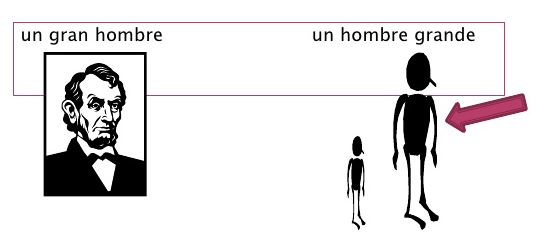One of the first things that every Spanish student learns about adjectives is that they follow nouns: think Casablanca, perro caliente, and living la vida loca. But sooner or later, this neat picture becomes muddled as our student learns that adjectives can also precede nouns, usually with some change in meaning (see the illustration below). I was curious to know how often adjectives appear in these two locations in actual usage. Do they usually follow nouns, and if so, by what margin?
 Fortunately, the perfect resource exists to address this question quantitatively and painlessly: Mark Davies’s hundred-million word Corpus del Español. I downloaded the freely available list of the 50,000 most common two-word sequences in the 20th century portion of this corpus, some 20 million words. I then compared the frequency of the noun-adjective and adjective-noun sequences on this list, omitting special types of adjectives that always come before nouns: possessives like mi ‘my’ and tu ‘your’, demonstratives like este ‘this’ and ese ‘that’, ordinal numbers like primero ‘first’ and segundo ‘second’, and quantifiers like mucho ‘many’ and algunos ‘some’.
Fortunately, the perfect resource exists to address this question quantitatively and painlessly: Mark Davies’s hundred-million word Corpus del Español. I downloaded the freely available list of the 50,000 most common two-word sequences in the 20th century portion of this corpus, some 20 million words. I then compared the frequency of the noun-adjective and adjective-noun sequences on this list, omitting special types of adjectives that always come before nouns: possessives like mi ‘my’ and tu ‘your’, demonstratives like este ‘this’ and ese ‘that’, ordinal numbers like primero ‘first’ and segundo ‘second’, and quantifiers like mucho ‘many’ and algunos ‘some’.
In this reduced data set, noun-adjective sequences indeed outnumbered adjective-noun sequences, accounting for 60% of the data. The textbooks are right! What was particularly striking was the degree to which a few adjectives dominated the adjective-noun group. The ten adjectives that most frequently preceded nouns (grande, mayor, bueno, nuevo, próximo, cierto, alto, largo, principal, and propio) accounted for 75% of adjective-noun occurrences. Grande alone accounted for 24%. In contrast, the ten adjectives that most frequently followed nouns (político, humano, pasado, siguiente, económico, nacional, social, general, público, and internacional) accounted for only 30% of noun-adjective occurrences.
Also striking was the disjunction of the two lists. 331 distinct adjectives in the dataset occurred after nouns, and 62 before nouns, but only 20 occurred both before and after nouns. For the curious, these were actual, antiguo, bajo, corto, determinante, difícil, especial, fuerte, importante, largo, libre, mayor, pasado, principal, propio, próximo, siguiente, vecino, vital, and vivo. Note that this list includes only half of the top ten adjectives that preceded nouns (mayor, próximo, largo, principal, and propio) and only two of the top ten adjectives that followed nouns (pasado and siguiente). Grande, the adjective responsible for 24% of adjective-noun sequences, was completely lacking in the noun-adjective sequences. Presumably it would show up if one were to extend the analysis to lower-frequency word sequences.